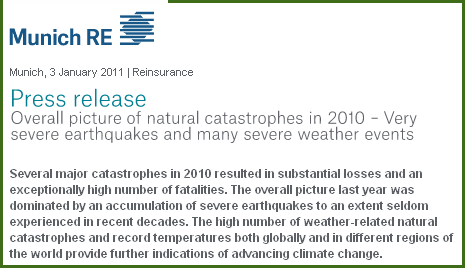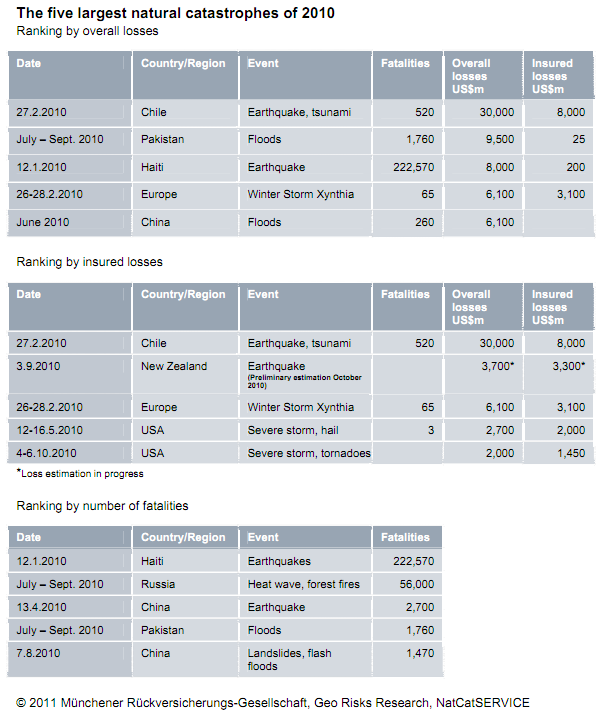
A total of 950 natural catastrophes were recorded last year by the major re-insurance company MunichRe. The company says nine-tenths of the incidents were weather-related events like storms and floods. This total made 2010 the year with the second-highest number of natural catastrophes since 1980, markedly exceeding the annual average for the last ten years (785 events per year).

The overall losses amounted to around US$ 130bn, of which approximately US$ 37bn was insured. This puts 2010 among the six most loss-intensive years for the insurance industry since 1980. The level of overall losses was slightly above the high average of the past ten years.
“2010 showed the major risks we have to cope with. There were a number of severe earthquakes. The hurricane season was also eventful – it was just fortunate that the tracks of most of the storms remained over the open sea. But things could have turned out very differently”, said Torsten Jeworrek, Munich Re’s Reinsurance CEO. “The severe earthquakes and the hurricane season with so many storms demonstrate once again that there must be no slackening of our efforts to analyse these risks in detail and provide the necessary insurance covers at adequate prices. These prices calculated by the insurance industry make it possible to assess the economic consequences of these otherwise difficult-to-evaluate risks.”
In all, there were five catastrophes last year assignable to the top category of “great natural catastrophes” based on the definition criteria of the United Nations: the earthquakes in Haiti (12 January), Chile (27 February) and central China (13 April), the heatwave in Russia (July to September), and the floods in Pakistan (also July to September). These accounted for the major share of fatalities in 2010 (around 295,000) and just under half the overall losses caused by natural catastrophes.

One of the most devastating earthquakes in the history of the past 100 years, the quake in Haiti on 12 January killed more than 220,000 people. Only the 1976 Tangshan earthquake in China claimed more lives (242,000). Whilst the earthquake in Haiti resulted in human tragedy on a staggering scale, it gave rise to only negligible losses for the insurance industry, as is so often the case in developing countries.
Five-hundred times more energy than in the Haiti quake was released by the earthquake that hit Chile just over a month later. With overall losses of US$ 30bn and insured losses of US$ 8bn, this quake was last year’s most expensive natural catastrophe. Chile is a highly developed country with very strict building codes to take account of the high earthquake exposure. As a result, there were comparatively few human casualties, despite the severity of the quake – the fifth-strongest ever measured – although people were killed in Chile, too.
In the summer, floods following extreme monsoon rainfall had devastating consequences in Pakistan. For weeks, up to one-quarter of the country was flooded. Countless people lost all their worldly possessions. The overall loss totalled US$ 9.5bn – an extremely high amount for Pakistan’s emerging economy.
A widescale catastrophe also resulted from the heatwave in Russia and neighbouring countries between July and September. Many places, including Moscow, experienced record temperatures. In some regions of central Russia, they exceeded 30°C for two months on end. Forests burned, with the fires threatening nuclear facilities and areas where the ground had been contaminated by radioactive fallout from Chernobyl. At least 56,000 people died as a result of heat and air pollution, making it the most deadly natural disaster in Russia’s history.
The hurricane season in the North Atlantic was benign – but only at first glance. Favourable weather patterns meant that the US coast was not hit by a single hurricane. In Mexico, however, a few storms caused substantial damage. Otherwise, the tropical cyclones turned away in a northeasterly direction over the sea, only grazing some islands in the Caribbean.
But what appeared benign was, in terms of the number and intensity of the storms, one of the severest hurricane seasons of the past 100 years. Altogether, there were 19 named tropical cyclones, equalling the number recorded in 1995 and putting 2010 in joint third place after 2005 (28) and 1933 (21). Twelve of the storms attained hurricane strength, with five of these falling into the top hurricane categories (wind speeds over 178 km/h). This means the forecasts of various institutes about the number of storms turned out to be very accurate. “The number of storms was indeed well above average. It is just that it is impossible to forecast whether and where such storms will make landfall”, said Prof. Peter Höppe, Head of Munich Re’s Geo Risks Research.
Right at the start of the 2010 hurricane season, the water temperatures in the tropical North Atlantic were up to 2°C above the long-term mean – and thus significantly higher than the level to be expected for the cyclical warm phase in the North Atlantic that has persisted since 1995. The water temperatures thus provided ideal conditions for the occurrence and high intensity of hurricanes. As from the beginning of August, atmospheric conditions also favoured the occurrence of Atlantic tropical cyclones (“La Niña” conditions).
“That is in line with the trend of the past 30 years, in which all ocean basins show an increase in water temperatures. This long-term trend can no longer be explained by natural climate oscillations alone. No, the probability is that climate change is contributing to some of the warming of the world’s oceans”, said Höppe. “This influence will increase further and, together with the continuing natural warm phase in the North Atlantic, is likely to mean a further high level of hurricane activity in the coming years.”







Crikey is committed to hosting lively discussions. Help us keep the conversation useful, interesting and welcoming. We aim to publish comments quickly in the interest of promoting robust conversation, but we’re a small team and we deploy filters to protect against legal risk. Occasionally your comment may be held up while we review, but we’re working as fast as we can to keep the conversation rolling.
The Crikey comment section is members-only content. Please subscribe to leave a comment.
The Crikey comment section is members-only content. Please login to leave a comment.